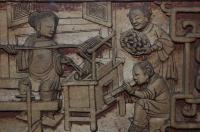Dongyang wood carving

Dongyang, a city in the middle of Zhejiang province, is famous for its woodcarving. It is one of the major centers of woodcarving production from the Ming (1368-1644) and Qing (1644-1911) dynasties to the present.
Dongyang woodcarving was in its development stages by the time of the Tang dynasty (618-907), but was most prosperous in the last two feudal dynasties -- the Ming and the Qing.
The artistic forms of Dongyang woodcarving with its distinctive gradations and superb carving are unique in the handicraft and art fields.
Dongyang woodcarving, also sometimes called "white woodcarving" (white is the natural color of the wood) and is second to none in terms of Chinese crafts. In terms of techniques, Dongyang woodcarving features a high relief, multi-layers, and a rich composition of pictures, presenting a great depth of dimension.
The woodwork is mainly used to decorate houses and furniture with realistic depictions of galloping horses, cranes, lotus flowers and people.
Nowadays, there are 2,700 different varieties of Dongyang woodcarving products, most of which -- covering 90 percent of total output value -- are daily wares such as cases, cabinets, stools, desks and tables. They are exported to more than 30 countries and regions, with over 3,000 craftsmen employed in 200 enterprises in Dongyang to make them.

 Print
Print Mail
Mail
 20 Cultural Symbols
20 Cultural Symbols Why Zhejiang
Why Zhejiang Experiencing high-tech products at WIC
Experiencing high-tech products at WIC Zhejiang Release
Zhejiang Release Zhejiang News
Zhejiang News